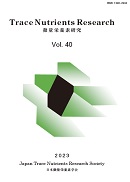Current issue
Displaying 1-21 of 21 articles from this issue
- |<
- <
- 1
- >
- >|
Original Article
-
Article type: Original Article
2023 Volume 40 Pages 1-5
Published: December 15, 2023
Released on J-STAGE: March 29, 2024
Download PDF (927K) -
Article type: Original Article
2023 Volume 40 Pages 6-9
Published: December 15, 2023
Released on J-STAGE: March 29, 2024
Download PDF (819K) -
Article type: Original Article
2023 Volume 40 Pages 10-13
Published: December 15, 2023
Released on J-STAGE: March 29, 2024
Download PDF (796K) -
Article type: Original Article
2023 Volume 40 Pages 14-19
Published: December 15, 2023
Released on J-STAGE: March 29, 2024
Download PDF (747K) -
Article type: Original Article
2023 Volume 40 Pages 20-27
Published: December 15, 2023
Released on J-STAGE: March 29, 2024
Download PDF (865K) -
2023 Volume 40 Pages 28-33
Published: 2023
Released on J-STAGE: March 29, 2024
Download PDF (705K) -
2023 Volume 40 Pages 34-39
Published: 2023
Released on J-STAGE: March 29, 2024
Download PDF (985K) -
2023 Volume 40 Pages 40-45
Published: 2023
Released on J-STAGE: March 29, 2024
Download PDF (1499K) -
2023 Volume 40 Pages 46-51
Published: 2023
Released on J-STAGE: March 29, 2024
Download PDF (1402K) -
2023 Volume 40 Pages 52-57
Published: 2023
Released on J-STAGE: March 29, 2024
Download PDF (1298K) -
2023 Volume 40 Pages 58-62
Published: 2023
Released on J-STAGE: March 29, 2024
Download PDF (895K) -
2023 Volume 40 Pages 63-69
Published: 2023
Released on J-STAGE: March 29, 2024
Download PDF (893K) -
2023 Volume 40 Pages 70-76
Published: 2023
Released on J-STAGE: March 29, 2024
Download PDF (1489K) -
2023 Volume 40 Pages 77-80
Published: 2023
Released on J-STAGE: March 29, 2024
Download PDF (734K) -
2023 Volume 40 Pages 81-86
Published: 2023
Released on J-STAGE: March 29, 2024
Download PDF (693K)
Mini Review
-
2023 Volume 40 Pages 87-91
Published: 2023
Released on J-STAGE: March 29, 2024
Download PDF (1057K) -
2023 Volume 40 Pages 92-95
Published: 2023
Released on J-STAGE: March 29, 2024
Download PDF (1157K) -
2023 Volume 40 Pages 96-102
Published: 2023
Released on J-STAGE: March 29, 2024
Download PDF (885K) -
2023 Volume 40 Pages 103-106
Published: 2023
Released on J-STAGE: March 29, 2024
Download PDF (738K) -
2023 Volume 40 Pages 107-111
Published: 2023
Released on J-STAGE: March 29, 2024
Download PDF (743K) -
2023 Volume 40 Pages 112-116
Published: 2023
Released on J-STAGE: March 29, 2024
Download PDF (1525K)
- |<
- <
- 1
- >
- >|
